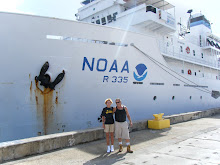BotCams
By Jake Asher
Left: A Bot Cam being deployed.
The BotCam is a flexible, non-extractive, and economical means to better understand deepwater ecosystems and improve science-based ecosystem approaches to management. BotCams collect video data that can be used to assess relative fish abundance and measure fish size. Information regarding fish habitat preferences, and depth ranges and zonation of the target species is also collected. This information is essential for evaluating the status of fishery resources in the CNMI and this project with be a step forward towards collecting this information.
Right: Floats are used to mark the BotCam locations.
The PIFSC CRED and University of Hawaii, in cooperation with several agencies, originally developed the prototype, deep water (350 m) camera (BotCam) station that was used as a cost-effective and non-extractive method to assess and monitor bottomfish and other commercially important deep water species. Designed as a fully autonomous stereo-video camera system, the components are housed in an aluminum frame 1.2 m wide, 0.5 m deep, and 0.45 m tall and designed to protect the camera and maintain fixed camera positions for accurate length measurements. The systems include programmable control functions which allow for the activation of imaging systems, bait release mechanisms, along with image scaling indicators. The BotCam can be deployed repetitively during a survey of a site or can sit dormant on the seafloor ready for activation at a preset time. Further, the stereo-video configuration of the camera systems allow for the sizing and ranging of both fish and benthic features.
Left: A BotCam being recovered.
The BotCam system is moored to the bottom by lead weights attached to an anchor line and is designed to float above the bottom and to record video by pointing horizontally down current with a downward angle of 10 to 20 degrees. This orientation improves the view of the benthic habitat without sacrificing the field of view. The BotCam system was set to begin recording after its release from the boat, but prior to its arrival on the bottom. For each deployment, the recording duration was between 45 and 60 minutes. The frozen bait consists of ground baitfish, and the volume used for each deployment was standardized to approximately 1 liter. The bait was placed in a simple plastic mesh container which allowed the bait to begin thawing and, therefore, dissipate as soon as the system was placed in the water. The bait station was considered to have started when BotCam arrived at the seafloor, as determined from the video. From that point, the cameras were allowed to record for a minimum of 30 minutes before BotCam was recovered. The entire system is recovered via line haul, including the anchor. BotCam is designed to have a minimal impact to the benthos; it is attached to a lead anchor by a line and sits between 1 and 3 meters above the bottom. The area of the anchor is about one square foot. Additionally the system is weighted in such a way that drag is minimized to protect seafloor habitats.
skip to main |
skip to sidebar




A survey of Fish around Guam and the CNMI to 250 meters
About this Cruise
This month-long cruise aboard the NOAA Ship Oscar Elton Sette brings together six diverse teams to survey fish populations using non-catch methods. Traditionally, fish populations have been assessed by catching fish, visiting fish markets and interviewing fishermen. Chief Scientist Scott Ferguson hopes to support Guam and the CNMI in monitoring their natural resources using non-extractive methods. The ship will also use multibeam sonar to map areas that are important fishery resources hopefully to include Galvez Bank, offshore slopes near Rota, and the banks of Farallon de Medinilla.
The survey methods include BotCams and BRUVs, two systems that put baited cameras on the bottom, and a TOAD which is a camera towed near the seafloor . An Autonomous Underwater Vehicle will travel on its own via computer programming and bring back photographs and video. Additionally, acoustic methods will be used to survey fish in the water column.
This expedition brings together scientists from NOAA’s Pacific Islands Fisheries Science Center and Northwest Fisheries Science Center, as well as the University of Hawaii’s Joint Institute for Marine and Atmospheric Research, the University of Guam Marine Lab, and Woods Hole Oceanographic Institution.
The survey methods include BotCams and BRUVs, two systems that put baited cameras on the bottom, and a TOAD which is a camera towed near the seafloor . An Autonomous Underwater Vehicle will travel on its own via computer programming and bring back photographs and video. Additionally, acoustic methods will be used to survey fish in the water column.
This expedition brings together scientists from NOAA’s Pacific Islands Fisheries Science Center and Northwest Fisheries Science Center, as well as the University of Hawaii’s Joint Institute for Marine and Atmospheric Research, the University of Guam Marine Lab, and Woods Hole Oceanographic Institution.
Pages
NOAA Ship Oscar Elton Sette

Fun Links
Rota, February 22-24
Galvez Bank, February 12-20

Linda and Lino prior to departure



